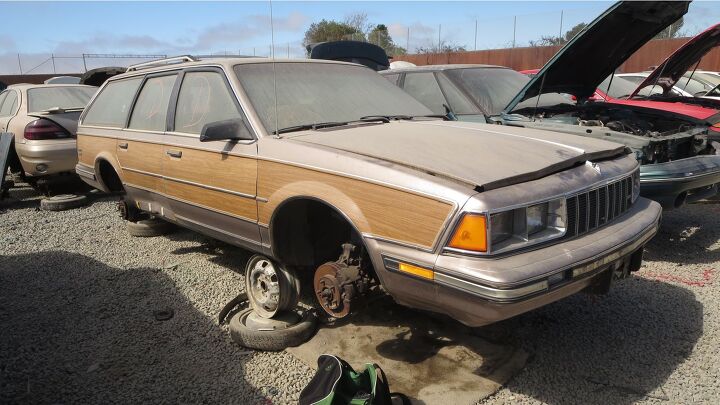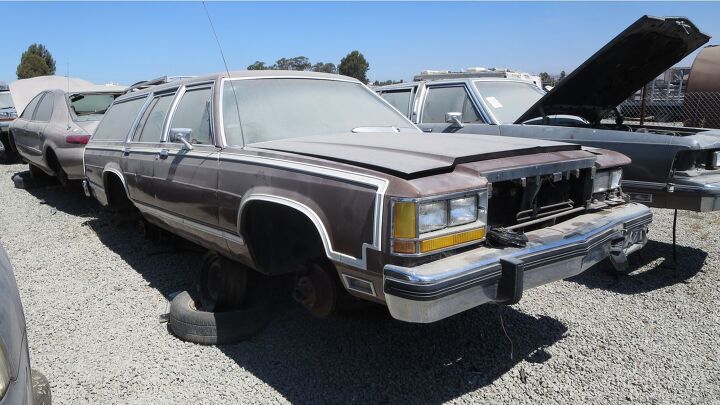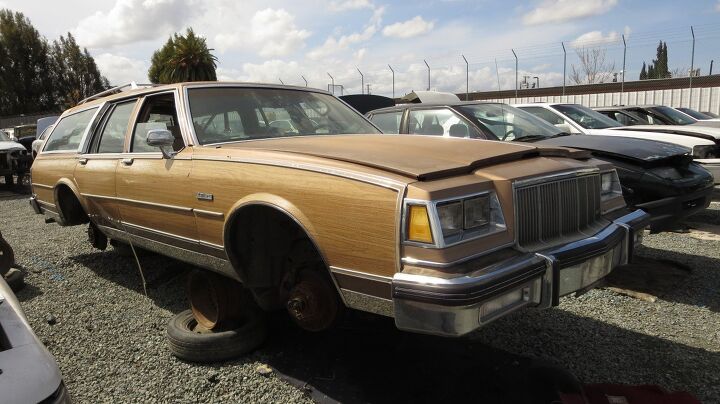#Woodie
Junkyard Find: 1984 Buick Century Estate Limited Woodie Wagon
The Chrysler K-platform-based minivans debuted for the 1984 model year, marking the beginning of the end of the station wagon’s mainstream appeal in the United States; not many years later, SUVs would snare most of the potential wagon buyers who didn’t get minivans.
Here’s a Buick Century wagon from that decisive year, spotted in a San Francisco Bay Area self-service wrecking yard.
Junkyard Find: 1982 Ford LTD Country Squire
Before Real American Families drove SUVs and minivans, they drove full-sized Detroit station wagons.
I’m not a wagon fanatic and it doesn’t break my heart that wagons are no longer mainstream (although it does break my heart that Chrysler didn’t bring back wagons with huge tailfins instead of the PT Cruiser), but I recognize that the archetypal Detroit wagon of the 1960s and 1970s was the Ford Country Squire. I can’t resist photographing a junked Squire when I see one in the junkyard, and so here’s a Late Malaise Era Country Squire I spotted in a San Francisco Bay area wrecking yard.
Junkyard Find: 1983 Mercury Marquis Station Wagon
In 1983, Ford decided to put the Mercury Marquis on the new-ish Fox Platform, while the Grand Marquis remained on the Panther Platform (where it would stay until the bitter end). Confused? Hey, at least the Marquis/Grand Marquis split wasn’t as puzzling as, say, the Toyota Corolla Tercel (which was unrelated to the Corolla) or the Nissan Stanza Wagon (which was only slightly related to the other US-market Stanzas).
Here’s a faded but generally solid ’83 Marquis woodie wagon I saw in Northern California in August.
Junkyard Find: 1989 Buick LeSabre Estate Wagon
The traditional full-size Detroit station wagon was in trouble by the end of the 1980s, thanks to the rise of the minivan. Increasingly car-like SUVs would kick the other leg out from under big rear-drive wagon sales during the 1990s, and so this great big GM B-platform wagon is one of the last of its type. Look, it’s even a woodie!
What's Wrong With This Picture: The Automotive "Farb" Edition
Serious Civil War reenactors have a term for folks who don’t measure up to those activists’ high standards for authenticity. They call them “farbs”, as in “far be it from me to criticize another enactor but if they want to be authentic they should be wearing hand stitched woolen underwear that hasn’t been changed or washed for two months, not BVDs”. Every hobby has its one-uppers. One of the things that I like about car culture is that it’s a mosaic of subcultures. Diversity can be a good thing and I’m a big tent car enthusiast. You may be a trackday fiend who would never slam a lowrider or restore a Messerchmitt microcar, but you can appreciate the folks who would and you can find common ground with them in your shared love of things automotive. Still, none of us like folks who put on airs. Every hobby, though, has its snobs.
We all love our cars and can bore even other car guys with minutia about our favorite marques and models, but at a car show with prewar Packards, don’t you think that it’s a bit pretentious to put “historical’ license plates on a Chrysler K-car?




















Recent Comments